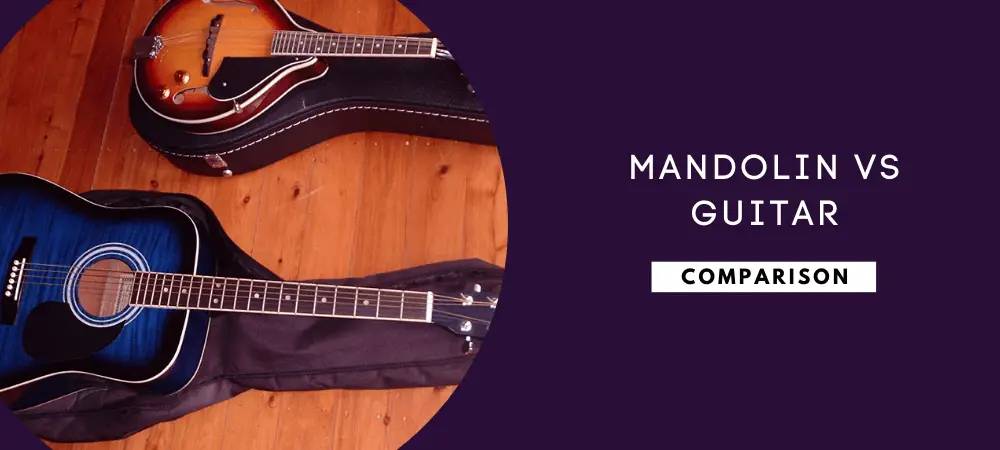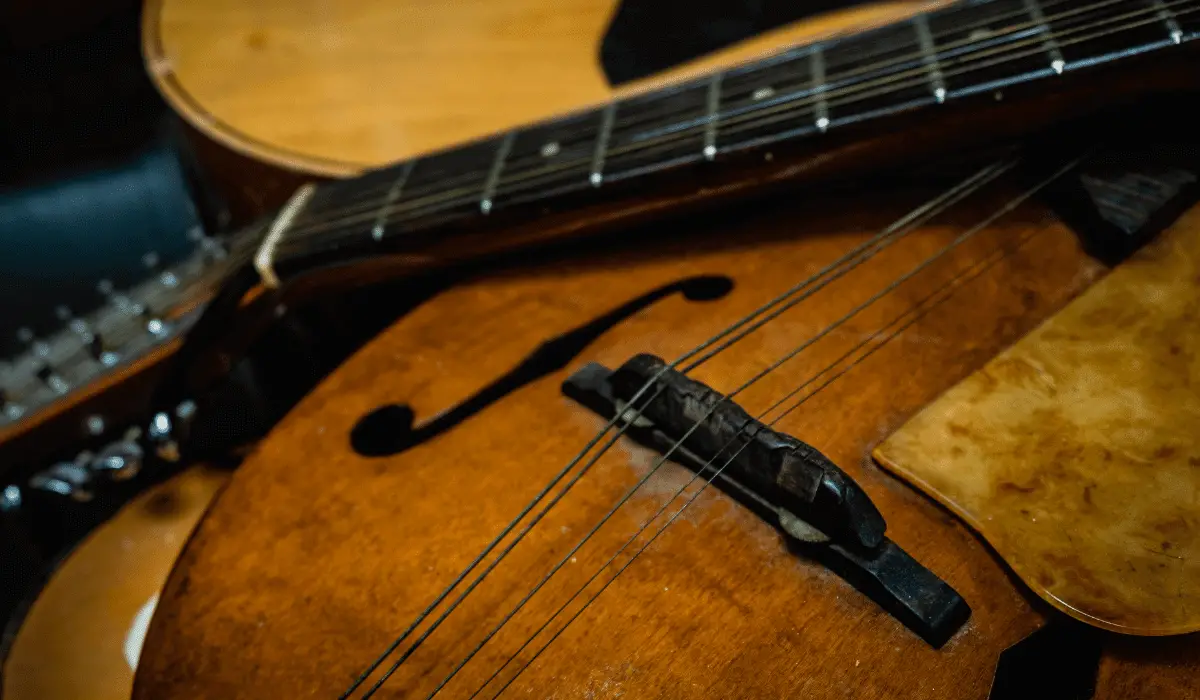Mandolin and guitar seem to be from the same family. They’re similar in a lot of ways while also having some major differences.
This article is the ultimate mandolin vs guitar battle.
Wondering if you can jump from learning mandolin to guitar or the other way around? Maybe you are not sure which instrument to start learning first? or if maybe you are just curious to know the differences between these two amazing instruments?
Either way, this article covers everything there is to know about the differences between guitar and mandolin.
Table of Contents
Mandolin vs Guitar: The recap
|
Instrument |
Mandolin |
Guitar |
| Strings | 4 (paired) | 6 or 12 |
| Size | Much smaller than the guitar | Bigger. You can also find small-sized guitars, though they will still be larger than the standard mandolin. |
| Tuning | Fifths ((G, D, A, E) | Fourths ((EADGBE) |
| Sound | Louder than the guitar. Perfect for solo performances | Not very loud. Great compliment for band performances |
The Differences Between Mandolin vs Guitar
The guitar and mandolin differ in various ways. In this article, we will cover both their physical and technical differences for a better understanding.
Strings
The mandolin has eight strings, which have paired to produce four sets of strings (although recently, some manufacturers have been making five-string mandolins). The strings are playable and open.
On the other hand, the standard guitar comes with 6 or 12 strings
Therefore, players who are used to the guitar might find it difficult to adjust to the mandolin’s 4 strings.
Why? Because making chords using only four strings isn’t as easy as doing the same with six strings.
Also, most players shudder at the thought of comfortably managing double strings. But, those who have tried both devices will tell that it isn’t even noticeable. The fear is just in mind.
Besides, the Mandolin strings are much thinner than those of the guitar, and even when doubled, they still can’t match the guitar-strings thickness.
Size
Another significant difference between mandolin vs guitar is their various sizes.
The full-size guitar is far more extensive than the standard mandolin. The mandolin is a small instrument, which attracts players for various reasons.
For example, small-handed individuals and younger kids will find the mandolin comfortable to hold and play thanks to its tiny size.
Also, according to music experts, the light mandolin strings are easy to press down, then the heavier guitar strings.
So, absolute string instruments beginners are likely to have ample time trying out the mandolin than the guitar. But of course, this depends on personal preference.
Although mandolins are smaller and comfortable to hold and possess light gauge strings, it doesn’t mean you should automatically choose the mandolin over the guitar. And this is why:
Those amazing small features that attract you to the mandolin can also be met by the guitar, only in a different way.
You can find fewer full-size guitars that can be played by both adults and children. Also, you can find some light gauge strings for your guitar.
Now, let’s get back to the size differences. Since the mandolin has a shorter and thinner neck, it’s more vulnerable to breakage than the guitar neck.
Also, it’s much more challenging to get to some frets on your mandolin, and you will have to resort to playing them using your fingernail.
This technique is more effortlessly said than done, but once you master it, playing will be fun.
You won’t deal with any of this when playing guitar. The frets are placed within reach lots of surface area for hand resting and bigger tuning pegs.
Tuning
The mandolin is usually tuned in the perfect fifths (G, D, A, E), similar to the violin tuning.
The only difference is that the violin has four single strings, while the mandolin has 4 double strings. But, that isn’t my focus today, so let’s keep moving.
The paired strings of the mandolin are tuned to the same note.
Because of its tuning, the mandolin is the best suitable country, classical, bluegrass, and folk music genres.
The guitar, on the other hand, as mentioned earlier, consists of six strings. And each of these strings is tuned to a different note.
The notes of the guitar are usually open and tuned into fourths (EADGBE: from the lowest note to the highest note).
Therefore, even if players with a guitar-playing history have it easy learning the mandolin, the chord shapes they had mastered from the guitar won’t help them with the mandolin.
Fun fact: if you turn your guitar upside down, you can now tune part in fifths, like the mandolin. And if you turn the mandolin upside down, you can tune it in fourths like the guitar.
Sound
Both the guitar and the mandolin sound differently. Therefore, it’s easy to choose between the two, if both sounds don’t appeal to you the same way.
Typically, mandolins produce the loudest sounds than the guitar.
If you’re listening to a performance, where the mandolin is part of the set-up, you’re likely to hear it slicing through the band sounds.
Because of its crispy clear, loud sound, the mandolin can easily be used in solo performances.
What makes the mandolin sound higher than the guitar is its short string length. Also, the tension on its strings is higher than the guitar.
But, if you decide to play them together, they will come out just fine. Their frequency ranges are different, meaning they won’t interfere with each other’s sounds but instead complement.
Technique
The mandolin comes with movable chords, just like the guitar.
However, you will have to use two frets per finger when playing the mandolin, instead of one fret per finger when it comes to the guitar.
When you’re told to do the 1st position in mandolin, it simply means you use your index finger to frets 1&2, the middle finger for frets 3&4, and the ring finger for frets 5&6, and the pinky finger for frets 7&8, as you go up.
Another technique that the guitar and mandolin players use is the angle and wrist method.
For example, guitarists would always reach across the fretboard of their instrument, while the mandolinists have to extend their hand and retract it along the length of their fretboard.
Therefore, when playing the mandolin, you will have to angle your hand like a fiddler. However, this should only worry you in the beginning.
When you get used to your instrument, it won’t be difficult to twist your hand as you want.
Difficulty
As mentioned earlier, the mandolin is smaller in size compared to the standard guitar. Therefore, if you have larger hands, you will experience some difficulty playing it.
Also, to play the mandolin perfectly, you will have to learn a few techniques. And this includes the use of both the left and the right hands.
But, this shouldn’t scare you if you have experience with stringed instruments. But if not, it might take you a little more practice to master.
The guitar, on the other hand, is considered easy to learn.
The instrument is large enough to accommodate both medium-sized and large hands. There are also some small-sized guitars for younger players.
Additionally, since the strings of the guitar are long, they present less tension.
Therefore, it’s easy to press them down as you play than you would with the short full of tension mandolin strings.
When playing the guitar, you will notice that your fingers hurt less, obviously because the strings don’t have much tension like the mandolin’s strings.
So, initially, players can comfortably play the guitar for long hours but have to use a short training session when learning the mandolin because the fingers are likely to hurt because of tightness.
History
It’s believed that the guitar is an outcome of the lute evolution.
Its history takes us back to the 16th century, where it’s said to have been invented in Spain, where it was derived from the Guitarra Latina.
Characterized by a waisted body and four strings, this instrument was Spain’s version of the Lute.
Because of its beautiful shape and ease of playability, the first guitar was seen as a feminine instrument. However, some men were bold enough to play it.
The 16th-century guitar featured a less outlined waist, but this has improved over time, which is evident today.
Also, the number of instruments in the first instrument was four, which has changed over time.
The numbers continued to increase with time, leading the current 6-12 strings of the modern guitar.
The guitar was introduced into the musical world around the 16th century, and it has been growing in popularity ever since.
In the 19th century, the Spanish guitarist Antonio Torres innovated the modern classical guitar shape.
But, it wasn’t until the 20th century that the guitar became a household name in the music sector. A fact that’s popularly attached to the rise of the famous American and Jazz music.
The mandolin, on the other hand, made its first appearance in the 16th century. Therefore, it’s younger than the guitar, although both instruments are believed to have evolved from the lute.
This explains why the mandolin still features a pear shape like the lute.
It’s believed that the mandolin was made more popular by the traveler players of the 17th and 18th centuries.
The players used to perform throughout Europe, explaining why it’s popularly used in European countries.
The mandolin gained popularity in the 2oth century, having been famously used in Jazz, classical, blues, and Celtic music performances.
Around the 1950s, the mandolin was embraced as one of the best student instruments and had been enjoying the privilege ever since.
Is Mandolin Easier to Learn Than Guitar?
It’s very easy to let the mandolin’s smaller size fool you into thinking that playing it is easy.
Far from the truth, the size has to do with how difficult it can be for beginners to master the mandolin than the guitar.
First, the tuning of the mandolin resembles that of the violin, which means there’s really no end to the learning process.
You will keep discovering new skills for the rest of your playing life.
And although the guitar is a lifelong study, most performers agree that it’s much easier to find your way through it than a mandolin.
Also, the mandolin has a smaller neck width than the guitar, which could be tricky for a previous guitar player to adjust.
But, if you can adjust to all these changes, it would be easy to play the mandolin, though not as easy as the guitar.
Young players might prefer the mandolin over the guitar, while large-handed beginners will learn the guitar quickly. So, it’s a matter of which instrument suits your need.
Therefore, if your focus is to find an easy-to-learn instrument, I would advise you to re-evaluate your mindset.
Because, if you’re truly determined to learn a specific instrument with a clear goal in mind, neither the mandolin nor the guitar will be too hard to learn.
Also, no instrument is too easy to master.
Once you get over the basics, you will have to keep on advancing your techniques, and any successful mandolin/guitar performer will tell you it requires dedication.
Conclusion
The heated debates about the guitar vs mandolin aren’t about to end anytime soon.
People will continue discussing their favorite instruments, with each group trying to project their preference as the best and the easiest to master.
And while it’s true that there are some advantages of being a mandolin player than the guitar, there are also many disadvantages of learning the guitar over the mandolin.
Therefore, since both instruments offer unique benefits to their players, it’s up to you to consider the pros and cons before choosing your side.
And while at it, don’t forget to consider the genre of music you prefer, your hands’ structure, playability, and the techniques needed, among other considerations stated in this article.
However, if you want to sound a little bit different and don’t want to join the crowd of commonly played instruments, the mandolin makes the perfect pick.






![How Hard Is It to Play the Banjo? [ANSWERED]](https://musictechhub.com/wp-content/uploads/2020/04/How-Hard-Is-It-to-Play-the-Banjo-250x170.png)